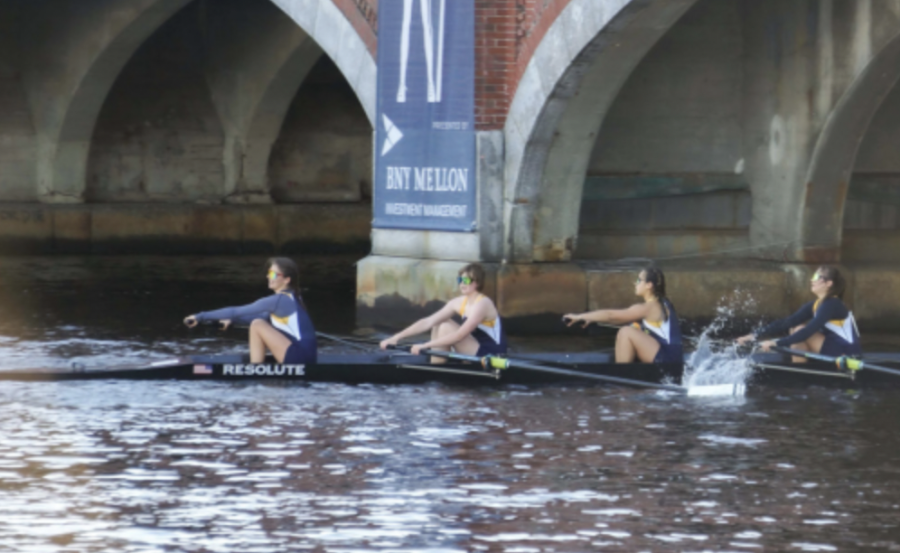HOCR brings school pride to a head
Community motivates rowers with cheers
November 2, 2021
Cheers erupted from the Elliot Bridge on the morning of October 24 as 50 students, parents, alumni, faculty, and staff watched the school’s Girls Varsity Four boat seize a narrow opening to overtake the boat in front of them in the final two minutes of the race. It was race time at the Head of the Charles (HOCR), the largest regatta in the world.
The loud cry of support at this critical point had a measurable effect on the speed and energy of the team, Coxswain Connie Yang ’22 said.
“It sounded like a mob,” she said. “It was really motivating. The boat got faster after listening to the BB&N cheering.”
Rowed by Arden Conine in stroke, Alicia Maginn (both ’22) in three seat, Enrica Parmigiani ’24 in two seat, and Sophia Chester ’25 in bow and coxed by Connie, the Girls Varsity Four posted a time of 20:56.911, shaving nearly 10 seconds off their best time. They placed 52nd out of 84 boats in the Women’s Youth Fours division.
The Boys Varsity Quad, a sculling boat, rowed on October 24 at 12:19 p.m. by Angus Crafter in stroke, Charlie Goebel in three seat, Harrison Grant in two seat, and Oscar Capraro in bow (all ’22) and coxed by Emmy Lev ’23, posted a time of 18:50.058 seconds and placed 35th out of 48 boats in the Men’s Youth Quad division. The boys’ boat added about a minute to their best time due to strong headwinds at the beginning of their race.
The Women’s Alumnae Eight was rowed by Marie Quintanar ’21, Genevieve O’Connell ’95, Klara Kuemmerle ’20, Meredith Coburn ’03, Rosi Kerr ’93, Taylor Richard ’14, Lucy Douglas ’90, and Deby Guzman- Buchness ’11 and coxed by Kate Ellias ’96, who were all asked to return to the school for HOCR and for a training session beforehand with Rowing Coordinator Stephanie Guilmet. They competed on October 23 at 11:46 a.m. Their time was 20:37.331, and they finished 45th out of 47 boats.
While a finish in the top half and qualification for next year evaded the school for all three boats, Girls Varsity Rowing Head Coach John Cotter said he was proud of how the girls fared considering their lack of experience and the choppy waters the 77 boats in front of them left in their wake.
“I’m very happy with the result,” he said. “They did better than I thought they would do. They haven’t done much racing, and they haven’t done this kind of racing.”
The nature of HOCR calls for mental strength and physical strength, Coach Cotter said.
“Someone might actually win the race even though many of the other boats never saw them. If the rowers don’t see any other boat for a few minutes, it can be mentally grueling,” he said.
The Girls Varsity Four maintained a rate of 29 strokes per minute for the first mile, 31 for the second, and 32 for the third—for each mile, they rowed two strokes per minute faster than they had planned.
“Youthful exuberance didn’t hurt them,” Coach Cotter said. “Whatever their max was, they hit it today.”
To secure a spot in the school’s HOCR boat, the rowers had to achieve one of the four fastest times of a 5000-kilometer erg test, and they had to have a firm grasp of the technique of the rowing stroke.
Coaches then designed lineups that optimized rowers’ skill sets. For example, in the Boys Varsity Quad, Angus rowed in stroke, as he was best able to serve as a metronome without visual feedback, while Harrison was in two seat, where he focused on exerting his physical strength as the rower with the fastest erg time.
Rowers trained two hours a day, five days a week, for the two months leading up to the race. Training included erg tests to improve fitness, drills with a focus on synchronizing strokes, and a run of the HOCR course once a week to familiarize the rowers with it.
“I had heard that [the training would be tough],” Oscar said, “but I was happy that there were five other guys going through it with me. That gave me the confidence to want to do it.”
Since rowers have no interaction with their opponents, stamina determines the victor, Boys Varsity Rowing Head Coach Adam Holland said.
“Fundamentally it’s about: How much work can you do? We are measuring each other’s engines against one another.”
The many hours of training certainly paid off when it came to race day, Girls Varsity Rowing Captain Arden said.
“All the hours we trained definitely made us all feel confident for the race,” she said. “Going in, we all knew exactly what to do because we practiced the course every week. That definitely helped the nerves.”
The school’s proximity to the Charles River allows the school to open its boathouse to visiting teams. In exchange for this community service, the school is favored in the lottery that decides which boats will take the rowing slots that do not go to qualifiers from the previous year. All three of the school’s boats this year won their spot through this lottery.
The HOCR course is emblematic of the broader school community that develops with time, Ms. Guzman- Buchness, who rowed in the alumnae boat, said.
“You start off at the BB&N boathouse, which is like starting off in high school at BB&N, and then you go up that river into the basin, and you see how many people and generations [came] before you,” she said. “Our whole team, our event happening here.”

